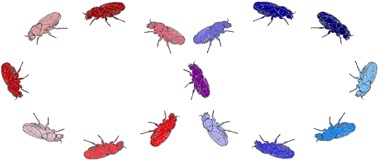What is the DSPR?
The Drosophila Synthetic Population Resource (DSPR)

consists of a new panel of over 1700 recombinant inbred lines (RILs) of Drosophila melanogaster, derived from two highly recombined synthetic populations, each created by intercrossing a different set of 8 inbred founder lines (with one founder line common to both populations). Complete genome sequence data for the founder lines are available, and in addition, there is a high resolution genetic map for each RIL. The DSPR has been developed as a community resource for high-resolution QTL mapping and is intended to be used widely by the Drosophila community.
Here you can track the progress of the development of the DSPR and find information regarding: the DSPR in general, our analytical machinery, and how to obtain the RILs and/or genomic data.
Motivation
Researchers ultimately wish to dissect the genetic basis of complex phenotypic traits to the nucleotide level, and functionally characterize the effect of the causative allelic substitutions. The DSPR is the next step toward this important goal. Previous approaches aimed at mapping traits, namely traditional QTL mapping and genome-wide association mapping, have significant drawbacks that have prevented widespread success addressing this issue. In traditional QTL mapping, there are few recombination breakpoints, thus, QTL are typically mapped to broad intervals containing an unmanageable number of genes. Genome-wide association mapping utilizes the pattern of historical recombination in natural populations and therefore has the potential for very high resolution. Unfortunately, this approach requires very large sample sizes and high-density SNP maps to achieve high power, and even so is prone to false-positives unless severe statistical correction for multiple testing is applied. The DSPR panel, created from initially crossing multiple inbred lines to make a synthetic population that then undergoes multiple generations of recombination before formation of recombinant inbred lines, represents an idealogical midway between traditional QTL mapping and genome-wide association mapping and has several advantages over these methods. The set of resources available to researchers utilizing the DSPR (a large panel of genotyped 8-way RILs, fully sequenced founders, and easy to use analytical software) will allow researchers utilizing the DSPR to move rapidly between phenotype and a small set of putative causative loci. Ultimately, as the DSPR is used more widely by the Drosophila community, researchers can address broader questions that require data on multiple traits mapped using the same set of RILs.
Advantages of the DSPR
Benefits of RILs
- Because the DSPR consists of recombinant inbred lines, genotyping need only be carried out once, phenotypes that cannot easily be scored on single individuals can be assayed (i.e., those of low heritability and/or with appreciable measurement error), and RILs facilitate the examination of genotype-by-sex, genotype-by-environment, and so on, interactions.
Wide range of natural variation
- The DSPR was created from a worldwide sample of 15 founder lines (South Africa, 2 lines; Asia, 4 lines; Australasia, 1 line; Europe, 2 lines; North America, 4 lines; South America, 2 lines). This panel therefore captures a large proportion of natural trait variation and provides a robust picture of trait genetic architecture.
Extremely high mapping resolution
- The DSPR is derived from highly recombined synthetic populations. This design allows for QTLs to be mapped to very narrow regions of the genome (1-2cM), encompassing just a handful of genes.
Joint estimate of QTL effect and frequency
- Each set of RILs is derived from eight inbred founders. This multi-founder composition permits an estimate of BOTH the effect and frequency of mapped QTL, allowing for an estimate of the contribution of each QTL to natural trait variation.
Identification of causative sites
- Researchers using the DSPR will be able to identify putative causative sites. For each mapped QTL, a QTL allele can be assigned to each founder. The whole genome re-sequencing data allows the small proportion of polymorphisms in phase with the QTL allelic configuration to be identified. This small set is highly likely to include the causative site.

